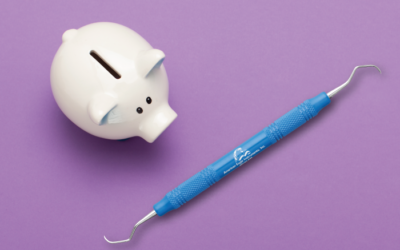Is your future in good hands? Being the highly skilled hygienist you are, the last thing that should be pinching your nerves are your instruments. Seriously, the design of your instrument handles can cause fatigue and even musculoskeletal injury to your hands. Contributing factors such as handle weight and diameter can result in increased “pinch force.” This is the cramping in your hand you may sometimes experience. Repetitive pinch force can lead to carpal tunnel syndrome, a condition that causes numbness and pain in the hand and arm from pressure on the median nerve. In one study, 75% of dental hygienists reported pain relating to the hands, and 56% reported symptoms of carpal tunnel syndrome. Sadly, this is a reason for the early retirement of many hygienists but luckily, this can be handled.
The Fine Design
Well-designed instrument handles allow a hygienist to operate in a modified pen grasp where the tips of the thumb, forefinger and middle finger are in a relaxed c-grip against an instrument for ergonomic micromanipulation. Implementing this ergonomic approach can extend the career of a hygienist and reduce the incidence of injury or chronic pain. The ideal handle design will promote the ability to obtain this relaxed grasp with reduced force throughout procedures. Handle weight, texture, diameter, and color are all features to observe.
Weight
Does the handle weigh you down? It’s amazing the difference even a gram can make for hand and wrist pain and fatigue relief. Research shows that the ideal weight of an instrument should be around 15 grams and balanced between both ends. The lighter the handle is, the less strain the hygienist may experience. American Eagle EagleLite® Handles are an example of superiorly light handles that are available in stainless and resin and weigh under 12 grams. Overall, these are better instruments for hygienists compared to solid metal instruments. Heavier handles cause strain on the hand and wrist over time as the weight initiates greater muscle activity and may require a tighter grip.
Texture
Does the handle rub you the wrong way? Because hygienists work in a wet environment, knurl patterns are an important ergonomic feature of hygiene instruments. Knurl patterns are the textured detail found on an instrument handle and may be crosscut, longitudinal, or serrated. The textured patterns allow for adequate grip and tactile perception with instrumentation. The aggressive knurl patterns found on the Quik-Tip™ Double-Ended Handles by American Eagle provide excellent tactile feedback. This example of an aggressive knurl pattern is the kind of instrument handle you want to reduce that pinch force and promote hand health. If you’re a hygienist that wears thicker gloves that reduce tactile sensation, like polychloroprene or latex, the texture of instrument handles will be paramount to compensate for that. The texture will reduce the risk of injury to the hygienist or patient by providing tactile perception and a non-slip grasp.
Diameter
Do you feel like you’re grasping a pen or holding a highlighter? Diameters are an important component in examining the ideal dental hygiene instruments. Especially for a hygienist with smaller hands, a handle of approximately 10 millimeters, combined with a weight of approximately 15 grams allows scaling to be more comfortable and effective. Hygienists may prefer slightly larger instrument handles if they have large hands or longer fingers. Another consideration is if the instrument handle has a coating of synthetic rubber or silicone, which increases the overall diameter of an otherwise slender instrument. Handle diameters improve grasp and friction, reducing pinch force and the risk of developing musculoskeletal disorders. Choosing a handle diameter that creates comfort allows hygienists to extend the life of their career while avoiding chronic pain.
Taper
Instrument handles offer a tapered or straight style. Research shows that tapered handles can improve the adaptation of the finger pads to the instrument handle during high-force pulling motions, making this style ideal for active therapies of debridement and scaling and root planing. A round and tapered-shaped instrument handle may provide more long-term fingertip comfort versus a straight style that requires a little more bending of the fingers.
Color
Colored handles bring organization and excitement to your kits. American Eagle’s Quik-Tip™ Double-Ended Handle comes in seven different colors. Color coding allows for quick identification of instruments in a kit (Barnhart blue! Gracey green!). Instead, you may consider color coding your instrument handles by the year they were ordered in an effort to track your instrument’s projected lifespan (blue was ‘22). A benefit here is that by knowing where your instruments are in your kit, prolonged hyper-extension of the arm is reduced. Correct instrument selection creates efficiency in your appointment time.
A Note On Technique
Because of the nature of the dental hygiene career, hygienists must also be mindful of techniques to further reduce the incidence of musculoskeletal disorders such as carpal tunnel syndrome. Developers of certain instruments such as XP® Sharpen-Free Thin know this and want hygienists to succeed in their ergonomic and productivity goals. These instruments require the modified scaling technique of shaving as opposed to the increased lateral force used in traditional “pop-off” scaling. Using instruments that maintain their sharp edge and allow for reduced muscle generation while scaling gives the hygienist the benefit of efficiency with ease.
Now You’ve Got A Handle On It
Clinician comfort is the primary goal when looking at instrument handles. Hygienists shouldn’t continue to adapt to less than ideal instruments, but instead, choose the instruments that suit their ergonomic needs. Knowing what features to look for when selecting instruments will grant confidence when procuring better ergonomic kits. By doing so, the prevalence of musculoskeletal disorders can be reduced or prevented and one can enjoy a happy career in hygiene.





